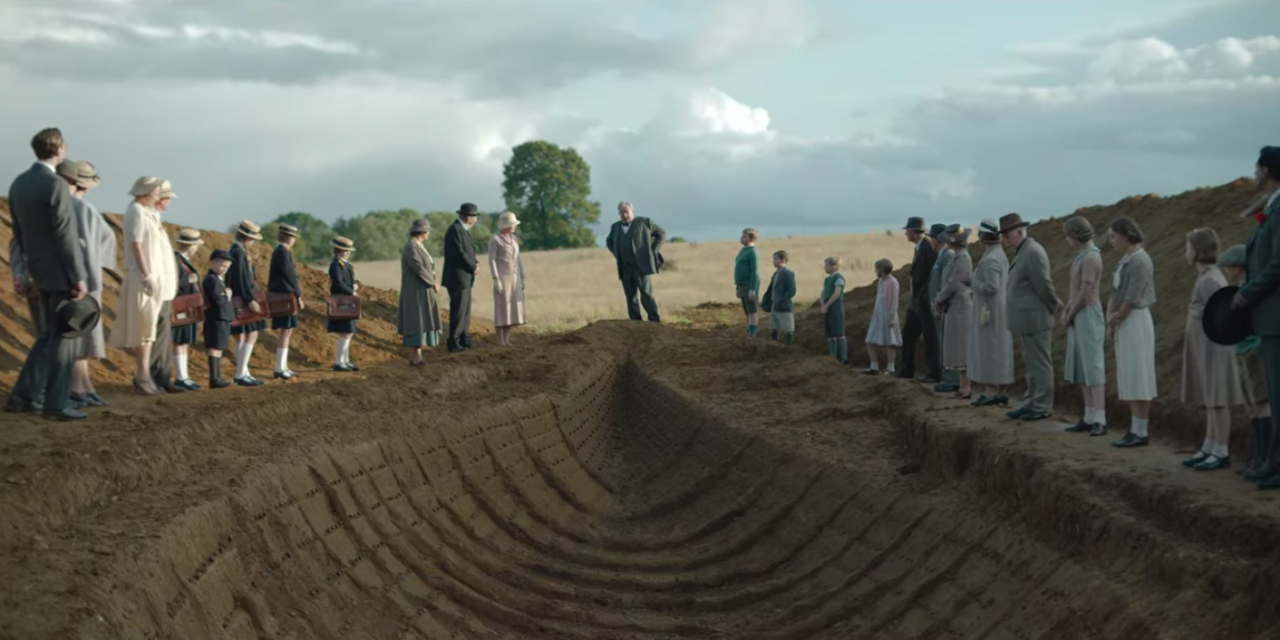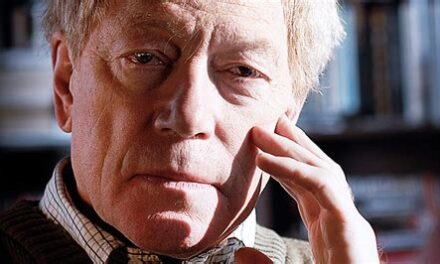When I use the phrase “little movie,” I realize I’m liable to be misunderstood—perhaps no more so than regarding the new film on Netflix “The Dig.” After all, it is about a fairly momentous event, the discovery in 1939 at Sutton Hoo in Suffolk, England, of the remains of an Anglo-Saxon burial ship, probably for royalty, and its treasure—coins, sword hilts, and a very famous war mask, all of consummate craftsmanship.
Anyone who’s seen the exhibition at the British Museum will appreciate how revelatory the find must have been (and still is, even behind glass): all of those claims in “Beowulf” of the mead hall Heorot’s being a “wonder of the world” were not a poet’s imagination run wild. Formerly, what most would call a bloody, barbaric world—as it surely was—now was understood as cultured in ways no one believed until Sutton Hoo told its story.
So why “little”? It’s a question of focus. Think about it. A script that dealt with an archaeological dig, however informative, might become dramatized documentary—worth watching but lacking the key elements of character and tension that lie at the heart of a good drama, little things that history books omit. “The Dig,” need I say, stresses them, and although it may not be 100% accurate in its portraits of the principals involved, it is in the best sense enthralling, highlighting the human amid the historical.
Edith Pretty, a widow living in a sprawling Suffolk country house, invites Basil Brown, an archaeologist—though one without academic credentials—from Ipswich Museum to investigate and, of course, excavate ancient burial mounds on her land by the River Deben. She’s particularly interested in his starting with the largest of the mounds, but he surmises it’s probably been “excavated” before, by grave-robbers, and prefers another. Yet it isn’t long before he decides Mrs. Pretty knew best and begins digging the large mound, a decision that will prove momentous. For as the work progresses amid delays of rain and one cave-in, the first sign of a great discovery becomes apparent: the almost perfect impression of a long decayed ship. Viking or earlier?
All of these elements of the plot are both necessary and predictable. But it’s the characters, like the ship under the mound, emerging gradually and deliberately from their own soil, that provide the interest.
Widowed in 1934, Mrs. Pretty is not entirely alone since she has her nine-year-old son, Robert; nevertheless, she seems very lonely and not altogether healthy. In her mid-fifties, she suffers from chest pains, which she dismisses as heartburn; in fact, the problem is permanently damaged heart valves from an earlier bout with rheumatic fever.
Played by Carey Mulligan (who at 34, somehow manages to project late middle age), she is lovely, pale, and somewhat spectral, as if death were her constant companion, which, indeed, it is. Yet she insists that Mr. Brown find what is in the mound and even reaches out to him in a way that appears a bit romantic (surely fictional) and tragically desperate, asking him to join her for dinner one night. She never discourages Robbie from hovering around the site and even helping Mr. Brown, but her spells of exhaustion and bed rest compose an ominous picture. If the dig is something to live for, her health battles with her enthusiasm in a fight, as the doctors have told her, she will lose.
Ralph Fiennes’ Brown enters the action gruff and competent. Experts will know better, but his broad Suffolk accent sounds utterly convincing, as do his manners from the pipe-smoking to the awkward respect he displays in the presence of an upper-crust lady. Never falsely modest, he knows years of experience have equipped him for this dig, and he proceeds carefully, never jumping to a conclusion the evidence doesn’t warrant.
Yet as the work progresses, he sees before anyone else that the “ship” may be hundreds of years older than the Vikings who raided and inhabited England at the time of Alfred the Great. As for his relations with Mrs. Pretty, he accepts the dinner invitation, but it never happens. His wife May (Monica Dolan) shows up unexpectedly and that’s that. With that wrinkle in mind, no suggestion of sexual longing for Mrs. Pretty is ever spelled out; the event is brief, somewhat tantalizing, but over before it begins.
Besides, May Brown is not without interest. She understands what her husband does: it’s about more than digging; it’s about preserving the past, reminding people—certainly including young Robbie—where they came from and who they are. This responsibility on the eve of war, with Spitfires flying over the site from a nearby base, speaks eloquently of why Britain must hold out against the Nazis.
In other words, although there’s archaeology aplenty in “The Dig,” there’s more than a trace of Burke and Churchill in the soil.
Conflicts abound in the story, largely when the experts from Cambridge and the British Museum show up, led by Charles Phillips (Ken Stott), and try to push Brown aside. Always conscious of his place, Brown bows to their wishes, but not Mrs. Pretty. It’s her land, she invited him, and he’ll continue the work with or without them. And so, Brown and the experts work together.
One of them, Peggy Piggott (Lily James) is the first to find evidence of the golden treasure that shocked the English world. That’s a matter of fact, but in “The Dig,” she has (not entirely factual) problems with her new husband (Ben Chaplin), an apparent bi-sexual, who cannot love her as she believes he should. In the mix is Rory Lomax (Johnny Flynn), Mrs. Pretty’s nephew, who is awaiting the call from the RAF even as Peggy and he fall in love.
Despite the pagan, almost Epicurean idea of the soul sprinkled here and there in the dialogue (individual immortality as historical memory), “The Dig,” slow and somber as it may be, remains a moving, intelligent, and highly satisfying work, worthy of the event that inspired it. It may not be for everyone (good films rarely are), but it’s well worth watching—likely as not, more than once.















This movie lied about Peggy’s marriage, as she did not separate from her husband and go with adieus man. They divorced only after decades of marriage. It lied about who took the dig photos – the 2 real people are never mentioned, and Peggy’s was not adulterous with the non-existent photographer who was a mere confection. But it was correct about finding the boat. That makes it 25% truthful.